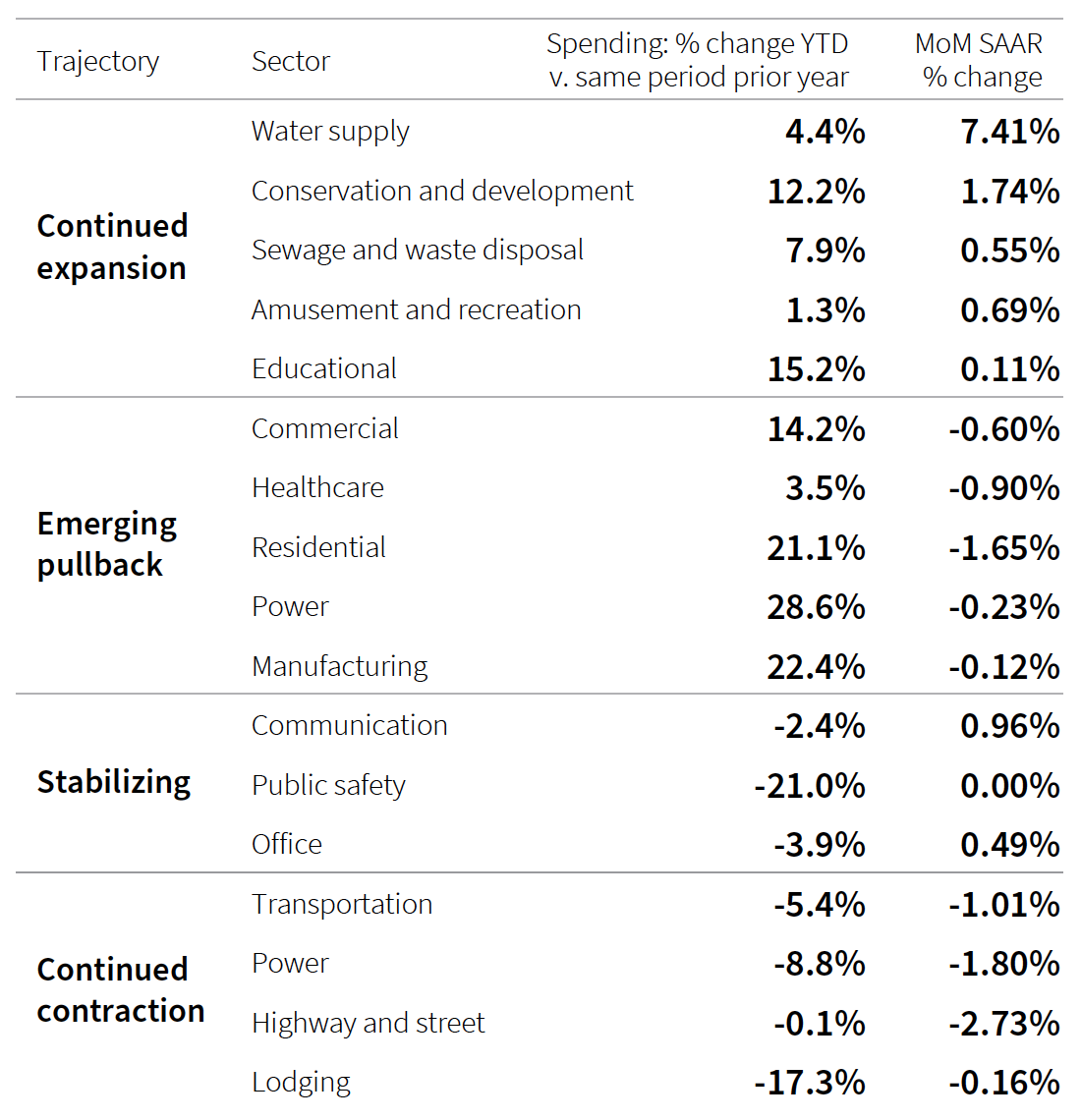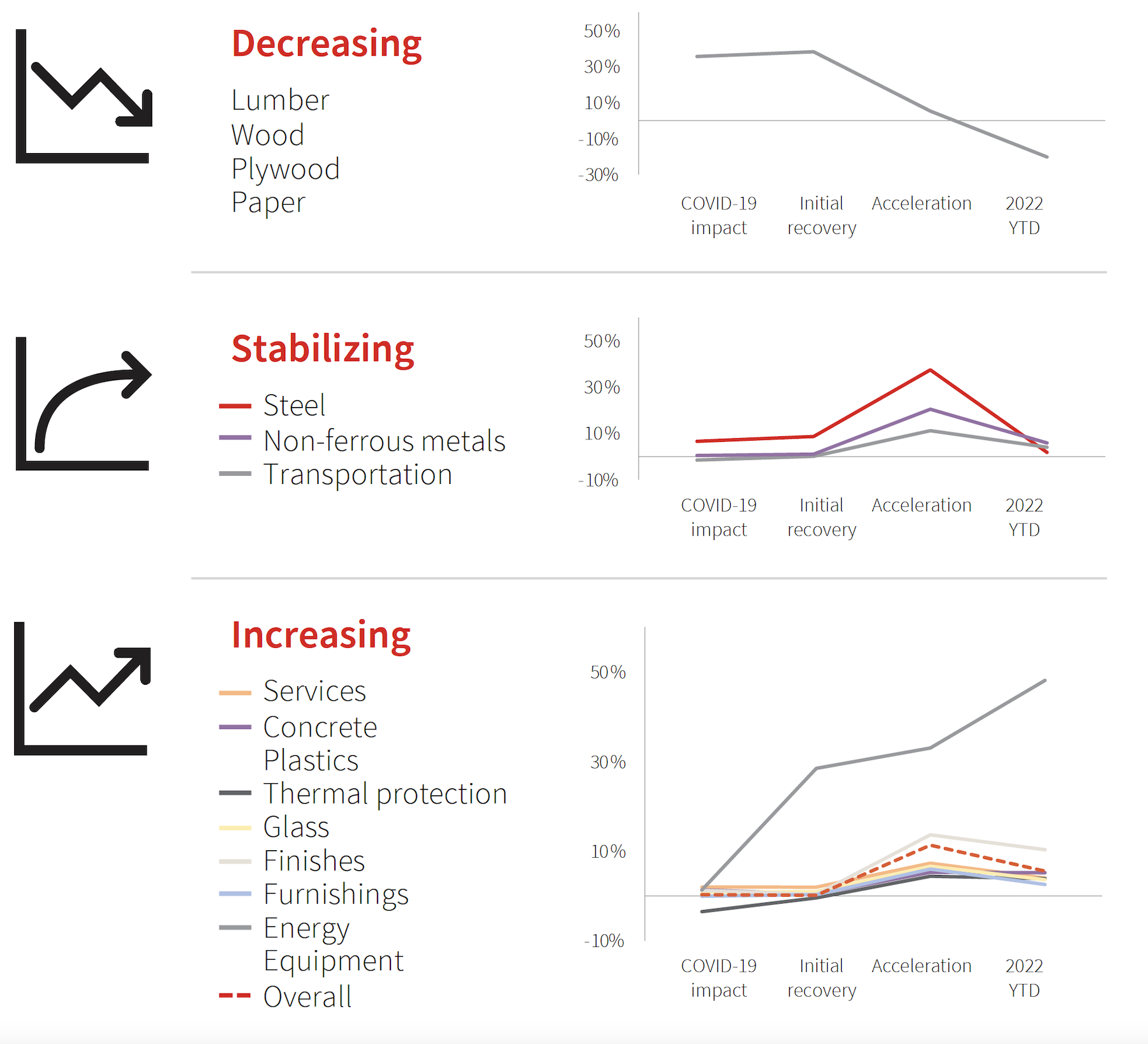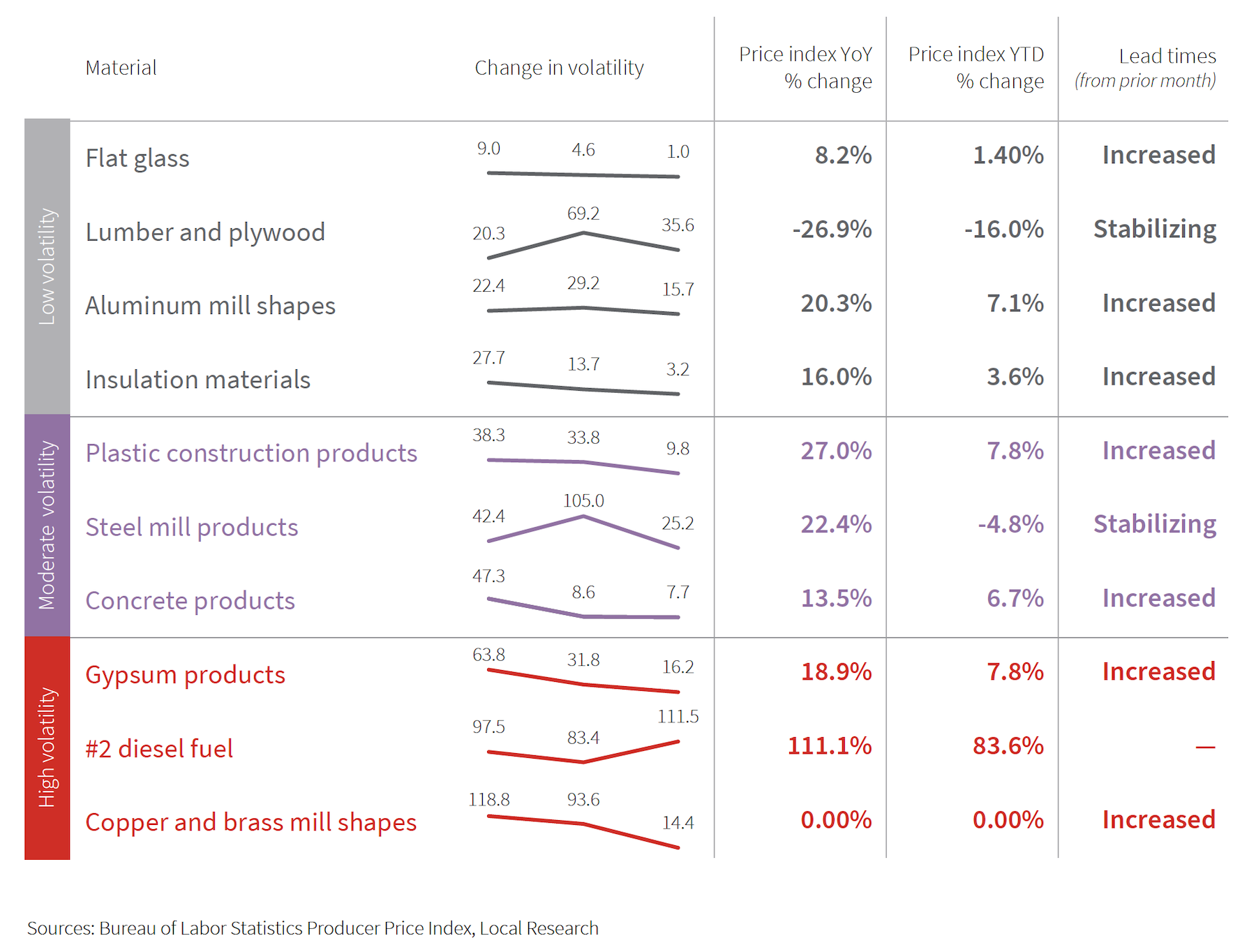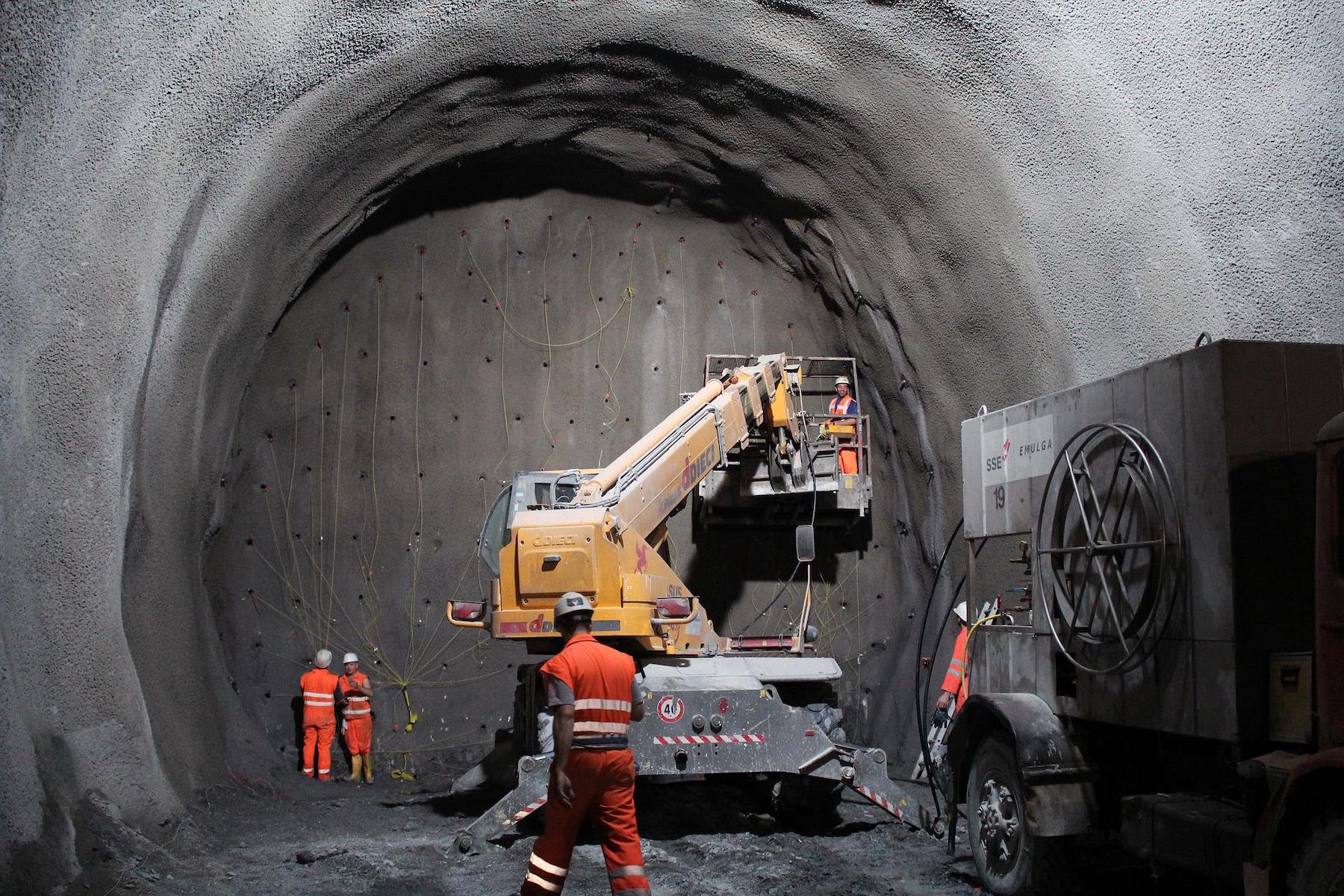Through the first half of 2022, nonresidential construction spending returned to “nomimal growth.” But JLL, in its Construction Outlook for the second half of the year, foresees nonresidential spending being flat, on an inflation-adjusted basis, and year-over-year growth returning to historical levels in 2024, “as disruptions are likely to persist into 2023.”
Those disruptions include supply-chain issues that contributed to construction materials costs increasing by 42.5 percent from prepandemic levels. Labor costs related to workforce shortages were 10.5 percent higher than they were in March 2020.
“Labor availability remains a deep-set structural challenge for the industry and will be a larger issue as construction demand persists and shifts focus,” JLL observes. “Estimates of future need based on these upcoming expenditures show the gap will only widen, with a particular need for nonbuilding and public workers.”
Too much work, too few workers

Job openings for construction labor have been consistently elevated, even as hiring expanded above prepandemic rates and separations fell to extremely low levels. In June 2022, unemployment fell to 3.7 percent, just 0.1 percent above the national average and job openings finally pulled back, dropping by 109,000 openings to 330,000. As such, the pullback is likely to continue, as firms stabilize backlogs and plan for difficult times.
Wage growth in the first half of 2022 was modest as well, significantly outpaced by inflation. Workers in the construction industry have actually experienced real wage losses of roughly 1.9 percent since the start of the pandemic. That gap widened in the first half of 2022 for construction employees.
“It is unlikely that the pullback will result in significantly lower demand side pressure in the construction labor market, as the current volume and array of work are sufficient to keep demand high for the next several years,” states JLL, especially once spending from the Infrastructure Investment and Jobs Act (IIJA) is in full swing.
The industry’s dilemma, however, is that it doesn’t have the capacity to fill every construction job that’s expected to be added in the next few years. At current forecasts of incoming IIJA funds bumping public spending by 10 percent or more annually from 2024 on, the increased need for construction employment equates to roughly 350,000 jobs from that spending alone —well above capacity identified in the historical record.
The largest impacts could be continued wage pressure and potential delays in projects. JLL predicts that the favorable situation for labor is expected to accelerate wage growth in the second half of the year, continuing to pressure margins. Though outright cancellations have remained limited, delays due to labor shortages are a nearly universal experience “with no relief in sight.”
Uneven price stability


JLL’s Outlook is mixed about construction materials availability and costs. Steel and lumber, once the poster children for price inflation, have stabilized, thanks in part to domestic steel construction that’s 30 percent higher than prepandemic levels. However, “volatility has not gone down uniformly” across the spectrum of construction products.
That is particularly true of energy related materials that have been affected by Russia’s invasion of Ukraine, whose damages to its built environment are estimated at $750 billion and rising. Cement, glass manufacture, and semiconductors for equipment and machinery “are among some of the larger price increases,” with concrete and glass disproportionately reliant on few producers with extremely high energy usage for production. Plus, the 10 percent increase in domestic cement and concrete production hasn’t stabilized prices yet.
Consequently, JLL has revised its previous outlook and now projects that materials prices will be up between 12 and 18 percent this year. “Uncertainty is still widespread and, as demonstrated by the current changing patterns of costs, novel issues are likely to emerge and disrupt supply chains and pricing in the near term.”
An active industry
From January to May 2022, the seasonally adjusted annual rate of total construction spending expanded at a monthly rate of 0.63 percent, above the growth rate observed in 2021. June, though, was down a percentage point, and any increases through the first half of the year were attributable to inflation.
On the bright side, JLL expects construction activity to remain healthy, global economic concerns notwithstanding. In the U.S., the Northeast has faltered with numerous months of contraction in the first half of 2022, while the West has picked up the pace of billing and backlog increases in recent months. The South and Midwest have maintained billings growth that is beginning to decelerate but will nevertheless create an appreciable pipeline of construction activity in the regions.
Related Stories
Market Data | Mar 26, 2024
Architecture firm billings see modest easing in February
Architecture firm billings continued to decline in February, with an AIA/Deltek Architecture Billings Index (ABI) score of 49.5 for the month. However, February’s score marks the most modest easing in billings since July 2023 and suggests that the recent slowdown may be receding.
K-12 Schools | Mar 18, 2024
New study shows connections between K-12 school modernizations, improved test scores, graduation rates
Conducted by Drexel University in conjunction with Perkins Eastman, the research study reveals K-12 school modernizations significantly impact key educational indicators, including test scores, graduation rates, and enrollment over time.
MFPRO+ News | Mar 16, 2024
Multifamily rents stable heading into spring 2024
National asking multifamily rents posted their first increase in over seven months in February. The average U.S. asking rent rose $1 to $1,713 in February 2024, up 0.6% year-over-year.
Market Data | Mar 14, 2024
Download BD+C's March 2024 Market Intelligence Report
U.S. construction spending on buildings-related work rose 1.4% in January, but project teams continue to face headwinds related to inflation, interest rates, and supply chain issues, according to Building Design+Construction's March 2024 Market Intelligence Report (free PDF download).
Contractors | Mar 12, 2024
The average U.S. contractor has 8.1 months worth of construction work in the pipeline, as of February 2024
Associated Builders and Contractors reported that its Construction Backlog Indicator declined to 8.1 months in February, according to an ABC member survey conducted Feb. 20 to March 5. The reading is down 1.1 months from February 2023.
Market Data | Mar 6, 2024
Nonresidential construction spending slips 0.4% in January
National nonresidential construction spending decreased 0.4% in January, according to an Associated Builders and Contractors analysis of data published today by the U.S. Census Bureau. On a seasonally adjusted annualized basis, nonresidential spending totaled $1.190 trillion.
Multifamily Housing | Mar 4, 2024
Single-family rentals continue to grow in BTR communities
Single-family rentals are continuing to grow in built-to-rent communities. Both rent and occupancy growth have been strong in recent months while remaining a financially viable option for renters.
MFPRO+ News | Mar 2, 2024
Job gains boost Yardi Matrix National Rent Forecast for 2024
Multifamily asking rents broke the five-month streak of sequential average declines in January, rising 0.07 percent, shows a new special report from Yardi Matrix.
K-12 Schools | Feb 29, 2024
Average age of U.S. school buildings is just under 50 years
The average age of a main instructional school building in the United States is 49 years, according to a survey by the National Center for Education Statistics (NCES). About 38% of schools were built before 1970. Roughly half of the schools surveyed have undergone a major building renovation or addition.
MFPRO+ Research | Feb 27, 2024
Most competitive rental markets of early 2024
The U.S. rental market in early 2024 is moderately competitive, with apartments taking an average of 41 days to find tenants, according to the latest RentCafe Market Competitivity Report.

















